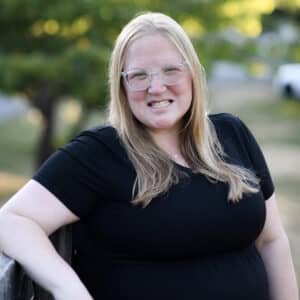Community Education Government
Peninsula School Board Position 2 | Two first-time candidates seek seat
Two-first-time candidates, Emily DuCharme and Matthew Bruhn, are seeking election to the Peninsula School Board representing District 2. Jennifer Butler, the District 2 incumbent since 2021, did not run for re-election.

Matthew Bruhn
DuCharme is the parent of two students in Peninsula schools. Among several volunteer roles she’s held in the district, DuCharme is the founder and vice-chair of the Peninsula School District Special Education Parent Committee (SEPAC).
Her top priorities, as stated in the Pierce County Voters’ Pamphlet, are “special education, inclusion and ensuring that funding reflects the real needs of students and educators.” She cites her advocacy for parents of students with special needs among her strengths and qualifications.
“I’m running for school board because every student deserves to be seen, supported and given the opportunity to thrive no matter their abilities, experiences or educational needs,” she says. “I understand how to navigate complex systems and how to advocate effectively within them.”
Bruhn is the parent of two young children in Peninsula schools. He describes his career as “a seasoned team leader with a track record of success at fast-growing technology companies.” Bruhn cites his leadership skills, saying they would translate effectively to the role of school board member. Among his stated priorities are transparency and accountability from the school board.
“My leadership is rooted in transparency, active listening, collaboration, and a belief that people do their best work when they feel supported and heard. These are the same values I’ll bring to the board,” he says. “If elected, I will advocate for open dialogue with families, clearer communication from district leadership, and fair access to resources across all schools. Parents, teachers and students deserve to feel included in the decisions that shape their schools.”

Emily DuCharme
Candidates responded by email to three questions from Gig Harbor Now. Their responses have been lightly edited.
Fiscal crisis looming
Peninsula School District Chief Financial Officer Ashley Murphy has warned that district finances will be stretched to the limit unless the state enacts a major funding formula revision for K-12 schools. While PSD’s budget is sustainable for now, a number of districts across the state are facing the K-12 equivalent of bankruptcy. That trend will spread barring seismic legislation in Olympia on par with the 2012 McCleary decision, Murphy predicts.
As the Peninsula School Board joins other districts in lobbying for change, what specifically should they ask for? How and where should the K-12 funding formula change? How should the state secure the increased revenue required to “fully fund” public education?
DuCharme
If we’re asking Olympia for change, I’d push in three areas:
First, update the state’s funding formula to reflect what schools actually look like in 2025. The “prototypical school model” is wildly outdated. It doesn’t fund the paraeducators, nurses, counselors or specialists actually needed. It underestimates the hours paraeducators actually work, and it doesn’t reflect today’s actual curriculum and technology costs.
Second, fully fund the things the state already mandates. Special education and transportation are two of the biggest examples. Right now, most districts are spending far beyond what the state allocates, because kids’ needs don’t fit into a cap or fall in line with a flat reimbursement rate. We need the state to cover the actual costs of serving students with IEPs (individual education plans), transporting students, and paying drivers and mechanics at market rates.
Third, make revenue predictable and equitable. Local levies shouldn’t be the Band-aid for core educational services, because that means a child’s opportunities depend on their zip code. We need the state property tax levy and other state-level revenue sources to keep pace with inflation and enrollment, and we need expanded levy equalization so every community can provide strong schools.
As far as how to fund it? I support a mix of solutions that are stable over time: modest adjustments to the state property tax levy, making sure it grows with costs, and closing certain tax loopholes or preferences to dedicate more revenue to education. The point is, we can’t keep telling schools to “do more with less.” If we want fully funded public education, we have to actually pay for it.
At the end of the day, this isn’t about numbers on a spreadsheet, it’s about whether kids get the teachers, paraeducators, counselors and programs they need to succeed. That’s what I’d want our board and all districts pushing for in Olympia.
Bruhn
I believe the district is doing a good job, but we need to stay vigilant as circumstances continue to change. As a parent, I was surprised to learn that many of the funding formulas in use today date back to when I was in school or even earlier. Updating these formulas is one of my top priorities because they determine how resources, staffing and salaries are allocated. Outdated systems leave us at a disadvantage from the start. By working with the state legislature, I want to take a data-driven approach to show the true costs of educating students and push for fair, sustainable funding.
Part of this effort includes making sure lower-income schools and families receive properly weighted support so every student has access to the opportunities they need. One of my core priorities is that our schools must be safe and equitable for every student.
It is also important to maintain what we already have. When I attended the University of Washington, many of the buildings dated back to the early 1900s. They were still heavily used alongside newer facilities, which shows the importance of long-term maintenance and sustainability rather than simply replacing old with new.
Our goal should be to use resources as effectively as possible, finding creative solutions that maximize every dollar while ensuring all students have access to safe, well-supported schools.
Equity and inclusion
The district’s strategic plan states as one of its goals an equitable and inclusive learning environment. “We will ensure an inclusive community and culture where everyone is safe, valued, respected, and finds a sense of belonging,” the plan states.
What grade would you give the district on meeting this goal? Where is PSD excelling? Where is it falling short? What should be done to address the shortfalls?
Bruhn
I have lived in the district for three years, and based on my experiences, I would give the district a C in this area. From students and teachers, I often hear concerns about equity, inclusion, and safety. I believe the district is trying, but we must be transparent about the challenges. The fact that a study had to be conducted last year after many complaints shows there is still room to grow. Sharing information openly, even if it reflects poorly, is how we rebuild trust and improve.
I have heard stories of bullying not being taken seriously or students having different opportunities depending on where they live. I have had to explain to my children why some of their friends no longer attend the same school or ride the same bus because their families chose schools with better programs or more supportive environments. I have also seen my own child picked on at school. Thankfully, many dedicated teachers work hard to keep students safe and supported, but they cannot do it alone.
The community also plays a crucial role. Schools often reflect the culture of the broader community, and we can all do better. I do believe the district is committed to safe and equitable schools, but where it falls short is in consistent enforcement of policies and in partnering with the community. If we want Gig Harbor to be inclusive for all, we must model those values for our students.
DuCharme
I’d give PSD a C on this goal. We’ve made meaningful progress, but there’s still a long way to go.
The district has embraced programs like Unified Sports and Unified Club at our two comprehensive high schools, and we’ve seen inclusive events like Day of Champions that bring students of all abilities together. These efforts show what’s possible when inclusion is a priority, and they help build the kind of culture we all want for every student in our district.
However, inclusion is still uneven from school to school, and often depends on individual teachers, principals, or parent advocacy. Families of students with disabilities, for example, often feel like they’re fighting for the basics rather than being welcomed as partners. And while the strategic plan talks about belonging, we still hear stories of kids who don’t feel safe or respected because of differences in ability, culture or identity.
To close those gaps, we need consistency and accountability. That means having clearer expectations. It means teachers and paraeducators need ongoing, practical training in inclusive practices and how to respond to bullying in ways that support the student and change the culture. It means creating structures like dedicated special education counselors, and making sure student and parent voices are actively helping to shape decisions. It also means measuring progress not just celebrating events, but tracking whether all kids truly feel valued and supported.
At its best, PSD shows it can create safe, inclusive spaces. And while the district highlights inclusive events, we need to ask: is that sense of belonging showing up in every classroom, every day? It’s not right now, and it needs to change.
Board transparency and community engagement
The Peninsula school board has been criticized during public comments at its meetings for poor community engagement and lack of transparency. The board in recent months has given statements on issues of high community interest and it has begun hosting town hall-style study sessions.
What else should the board do to build trust with parents, staff and community members?
DuCharme
The first step to building trust is consistent listening. Families, staff, and students feel like their input only matters when there’s already a crisis. I appreciate that the board has started experimenting with town halls and statements on high-interest issues, as that feels like we’re on the road to additional transparency. Engagement has to be ongoing, accessible, and two-way.
That means creating regular, predictable opportunities for dialogue not just at the board table, but in the community. For example: rotating listening sessions in schools, coffee chats with board members, or issue-specific forums where families and staff can weigh in before big decisions are made.
It also means communicating clearly and openly. Transparency isn’t posting a long PDF on the website, it’s making sure that EVERY parent can understand how decisions are made and what options are considered. Families shouldn’t have to decode jargon or dig through multiple tabs just to find out what’s happening in their schools.
The board needs to meet people where they are: showing up at community events, partnering with booster clubs and parent councils, and making sure underrepresented voices are actively invited to the table. Advisory councils like SEPAC show how powerful authentic collaboration can be when families feel included from the start, not as an afterthought.
Trust isn’t built by a single statement or event. It’s built over time when the board demonstrates through consistent action that it values transparency, welcomes diverse voices, and makes decisions with the community rather than for the community.
Bruhn
I am glad to see the board engaging more with the community, and I hope it is a response to the pressure they have felt from parents. That is how I ended up in this race. If I am going to complain, I also need to step up and work for change.
The number one complaint I hear from the community is communication, and it is not even close. Parents often say, ‘If they had just communicated better, I would be less upset.’ I felt this myself during the teacher shuffle, when I was given four different reasons why my children’s principal was moved. The answers contradicted each other, and I was left unsure of the truth.
Transparency begins with involving the community and being open, even when things are difficult. It is not about making the district look good. If we keep trying to convince people that problems do not exist, we will never rebuild trust. Community engagement from the board is important, but it also needs to flow through the entire district. Administrators and staff carry out daily operations, and they need to keep parents informed as well. The board can set the tone by creating a culture of openness and consistent communication.
Teacher engagement is also critical. Teachers are on the front lines, and they must feel heard. My focus on this is one reason I was endorsed by the Peninsula Education Association. Valuing teachers’ input strengthens the district’s ability to serve students and families.

